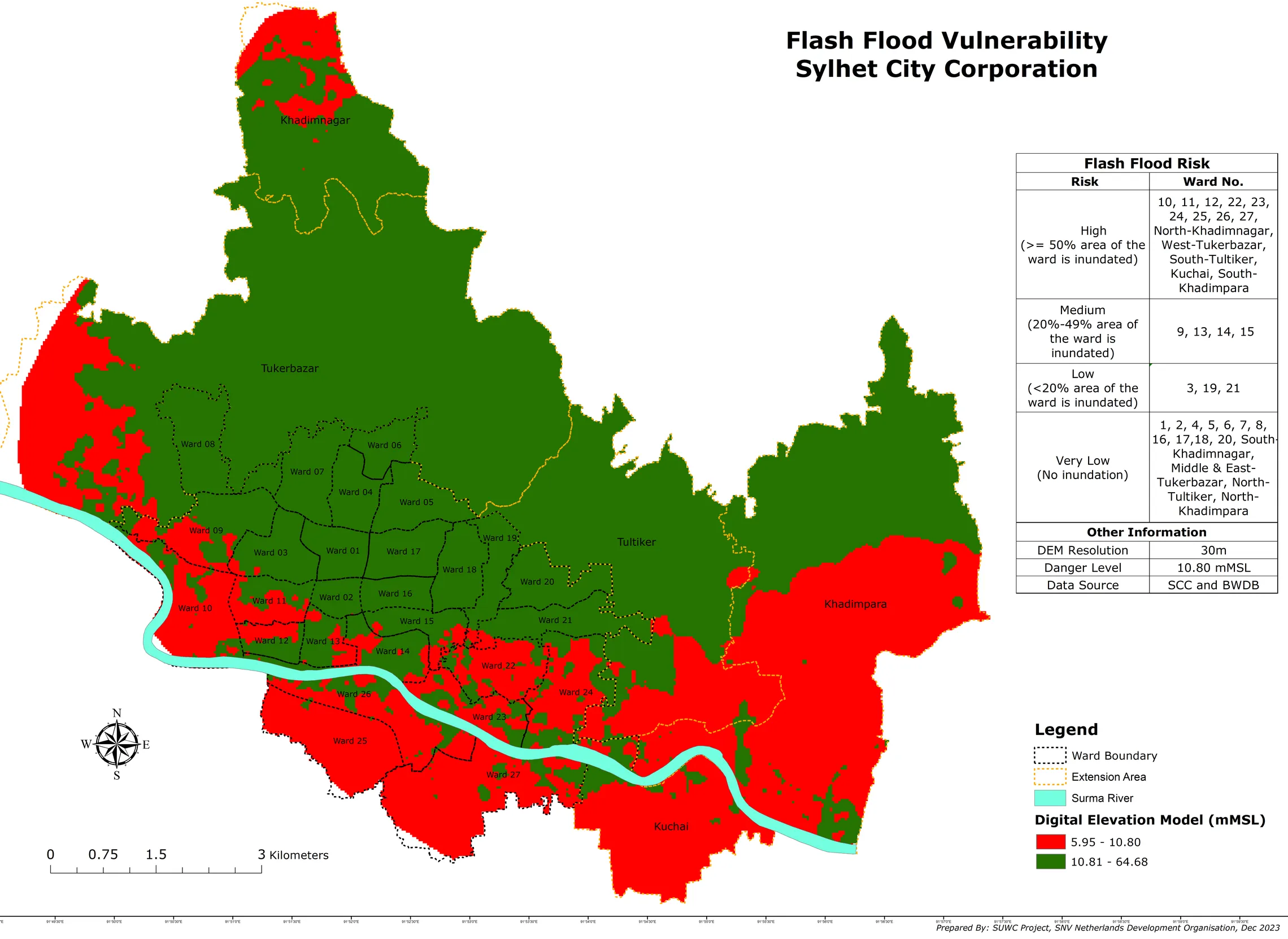Sylhet Bangladesh floods 2024
In early June, the Surma River in Sylhet surged past its 10.8m danger mark, displacing thousands. Now, just as the community starts to recover, the river levels are dangerously high once again.

We talked to our SNV colleagues, Md Imam Hossain, Drainage and Flood Management Advisor, and Patricia Solorzano, Project Manager. They are collaborating with government organisations and residents of Sylhet to mitigate the effects of flooding and improve solid waste management practices. We wanted to know more about the flood situation near Surma River and explore ongoing flood management strategies.
What causes the Surma River to flood?
Sylhet is prone to regular flooding during the monsoon season. Straddling the Surma River and located, between the Indian northeastern states of Meghalaya and Assam very high rainfall runoff upstream, and high siltation in the riverbed are huge problems. Unplanned infrastructure, drainage canals blocked by solid waste, and dense, impermeable land cover that causes waterlogging worsen the situation by disrupting the natural water cycle. Limited resources mean that efforts to dredge the river are unable to keep pace with the rate of incoming sediment.
When the river level reaches 10.4 mMSL (meters above the Mean Sea Level), Hossain explains, many of the city’s primary drains can no longer discharge stormwater into the river due to high levels of solid waste. The lack of space for water means the canals spill into the streets causing temporary waterlogging and flooding in some areas, affecting nearby communities, particularly those already economically and socially disadvantaged.
How does flooding impact nearby communities?
Flooding in the Surma-Meghna river system region exacerbates the issues of failing infrastructure, inadequate services, and rapid population growth by damaging infrastructure and investments, disrupting livelihoods, and hindering access to healthcare, education, water, food, and energy.
75% of the annual rainfall in Sylhet happens from June to August.
Suggested article: 'Sylhet's struggle against relentless flooding'
How is the local government responding to the flooding?
The Sylhet City Corporation (SCC) developed a flood mitigation strategy, which has recently been adopted by the Ministry of Water Resources.
The strategy builds on improving its early flood warning systems, constructing a 15 km dike along both sides of the Surma River, building a sluice gate and pump house at the outfalls in Malni Chhara, Boitha Khal, Goali Chhara, and Kushi Chhara, routine river, cleaning drains and canals, ending indiscriminate solid waste dumping, and researching factors that impede the natural flow of water in the Meghna Basin, land requirements for rainwater storage, and resolving system bottlenecks in the drainage network.
How is SNV supporting the SCC in flood mitigation?
SNV is conducting research projects with the Institute of Water Modelling to achieve comprehensive flood mitigation policy and action. We are co-developing behavioural change communication materials for flood preparedness and management, and solid waste management to improve drainage. We are advocating for the citywide implementation of a sponge city concept to complement drainage improvement systems.
Solid waste management and flooding links
What are some promising flood mitigation initiatives?
Several flood vulnerability analysis created by SNV using digital elevation modelling are now available to the SCC. These maps give important intel on the most flood-vulnerable areas in Sylhet, helping the SCC identify areas that require alternative and stronger early warning methods, immediate relief and medical operations, and flood-resilient structures.
Similarly, mapping out areas with less capacity to cope with peak stormwater discharge within Sylhet’s primary drainages could inform future investments for repairs or upgrade. At the Boitha Khal catchment where three of seven primary drainages were found at greater risk of being overwhelmed by flood waters, two urgent bottlenecks have been identified.
At the Ahad Mia Colony, the existing drainage size of 4.73 sqm is a little over 50% shy of the 9.90 sqm requirement.
At Liton's House, the existing drainage size is 5.55 sqm.
Solorzano tells us that improving solid waste management is important to mitigate flooding. In Sylhet, a focus on keeping drains clean to avoid water stagnation, and unobstructed – to ensure optimal drainage performance – will kickstart the upcoming SCC and SNV awareness campaigns.
Segregation and proper leachate management practice wanting
Suggested article: 'Managing Surma River flooding and environmental concerns'

How are communities empowered to take preventative measures?
The government is aware that only 10-15% of the population interacts with the official web-based early flooding warning system, with limited access to the Internet (50%) and TV cable networks. Further, communities have a role to play in ensuring the proper disposal of solid waste.
Solorzano shares that SNV and the SCC have partnered with Upward Spiral to co-design a behavioural change communication strategy. This strategy will mobilise community leaders and members to take the appropriate mitigation measures. In the coming months, the partnership will mobilise and train representatives from the town federation, community development committees (LIUPC/UNDP), and other social organisations to undertake preventative waste management efforts and co-create a more robust early warning system that benefits everybody.
Contact our Water experts, Md Imam Hossain and Patricia Solorzano through our Bangladesh office.
Take a deeper dive
In March 2024, the SCC and SNV hosted a learning event in Sylhet for 50 participants to explore possible institutional setups, possibilities for governance integration, and community engagement for a more sustainable urban water cycle.


